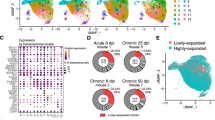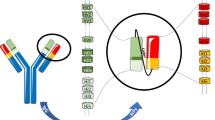Abstract
Vast diversity in the antibody repertoire is a key component of the adaptive immune response. This diversity is generated centrally through the assembly of variable, diversity and joining gene segments, and peripherally by somatic hypermutation and class-switch recombination. The peripheral diversification process is thought to only occur in response to antigenic stimulus, producing antigen-selected memory B cells. Surprisingly, analyses of the variable, diversity and joining gene segments have revealed that the naïve and memory subsets are composed of similar proportions of these elements. Lacking, however, is a more detailed study, analyzing the repertoires of naïve and memory subsets at the level of the complete V(D)J recombinant. This report presents a thorough examination of V(D)J recombinants in the human peripheral blood repertoire, revealing surprisingly large repertoire differences between circulating B-cell subsets and providing genetic evidence for global control of repertoire diversity in naïve and memory circulating B-cell subsets.
This is a preview of subscription content, access via your institution
Access options
Subscribe to this journal
Receive 6 digital issues and online access to articles
$119.00 per year
only $19.83 per issue
Buy this article
- Purchase on Springer Link
- Instant access to full article PDF
Prices may be subject to local taxes which are calculated during checkout


Similar content being viewed by others
References
Crotty S, Ahmed R . Immunological memory in humans. Semin. Immunol 2004; 16: 197–203.
Tonegawa S . Somatic generation of antibody diversity. Nature 1983; 302: 575–581.
Schatz DG, Oettinger MA, Baltimore D . The V(D)J recombination activating gene, RAG-1. Cell 1989; 59: 1035–1048.
Wilson PC, de Bouteiller O, Liu Y, Potter K, Banchereau J, Capra JD et al. Somatic hypermutation introduces insertions and deletions into immunoglobulin genes. J Exp Med 1998; 187: 59–70.
Neuberger MS, Milstein C . Somatic hypermutation. Curr Opin Immunol 1995; 7: 248–254.
Neuberger MS . Antibody diversification by somatic mutation: from Burnet onwards. Immunol Cell Biol 2008; 86: 124–132.
Schroeder HW, Cavacini L . Structure and function of immunoglobulins. J Allergy Clin Immunol 2010; 125: S41–S52.
Jackson SM, Wilson PC, James JA, Capra JD . Human B cell subsets. Adv Immunol 2008; 98: 151–224.
Tian C, Luskin GK, Dischert KM, Higginbotham JN, Shepherd BE, Crowe JE . Evidence for preferential Ig gene usage and differential TdT and exonuclease activities in human naïve and memory B cells. Mol Immunol 2007; 44: 2173–2183.
Rosner K, Winter DB, Tarone RE, Skovgaard GL, Bohr VA, Gearhart PJ . Third complementarity-determining region of mutated VH immunoglobulin genes contains shorter V, D, J, P, and N components than non-mutated genes. Immunology 2001; 103: 179–187.
Wu Y-C, Kipling D, Leong HS, Martin V, Ademokun AA, Dunn-Walters DK . High-throughput immunoglobulin repertoire analysis distinguishes between human IgM memory and switched memory B-cell populations. Blood 2010; 116: 1070–1078.
Boyd SD, Gaëta BA, Jackson KJ, Fire AZ, Marshall EL, Merker JD et al. Individual variation in the germline Ig gene repertoire inferred from variable region gene rearrangements. J Immunol 2010; 184: 6986–6992.
Boyd SD, Marshall EL, Merker JD, Maniar JM, Zhang LN, Sahaf B et al. Measurement and clinical monitoring of human lymphocyte clonality by massively parallel VDJ pyrosequencing. Sci Transl Med 2009; 1: 12ra23.
Arnaout R, Lee W, Cahill P, Honan T, Sparrow T, Weiand M et al. High-resolution description of antibody heavy-chain repertoires in humans. PLoS ONE 2011; 6: e22365.
Prabakaran P, Chen W, Singarayan MG, Stewart CC, Streaker E, Feng Y et al. Expressed antibody repertoires in human cord blood cells: 454 sequencing and IMGT/HighV-QUEST analysis of germline gene usage, junctional diversity, and somatic mutations. Immunogenetics 2011.
Tian C, Luskin GK, Dischert KM, Higginbotham JN, Shepherd BE, Crowe JE . Immunodominance of the VH1-46 antibody gene segment in the primary repertoire of human rotavirus-specific B cells is reduced in the memory compartment through somatic mutation of nondominant clones. J Immunol 2008; 180: 3279–3288.
Weitkamp JH, Kallewaard NL, Bowen AL, LaFleur BJ, Greenberg HB, Crowe JE . VH1-46 is the dominant immunoglobulin heavy chain gene segment in rotavirus-specific memory B cells expressing the intestinal homing receptor alpha4beta7. J Immunol 2005; 174: 3454–3460.
Gorny MK, Wang X-H, Williams C, Volsky B, Revesz K, Witover B et al. Preferential use of the VH5-51 gene segment by the human immune response to code for antibodies against the V3 domain of HIV-1. Mol Immunol 2009; 46: 917–926.
David D, Demaison C, Bani L, Theze J . Progressive decrease in VH3 gene family expression in plasma cells of HIV-infected patients. Int Immunol 1996; 8: 1329–1333.
David D, Demaison C, Bani L, Zouali M, Theze J . Selective variations in vivo of VH3 and VH1 gene family expression in peripheral B cell IgM, IgD and IgG during HIV infection. Eur J Immunol 1995; 25: 1524–1528.
Zouali M . Nonrandom features of the human immunoglobulin variable region gene repertoire expressed in response to HIV-1. Appl Biochem Biotech 1996; 61: 149–155.
Scamurra RW, Miller DJ, Dahl L, Abrahamsen M, Kapur V, Wahl SM et al. Impact of HIV-1 infection on VH3 gene repertoire of naive human B cells. J Immunol 2000; 164: 5482–5491.
Scheid JF, Mouquet H, Kofer J, Yurasov S, Nussenzweig MC, Wardemann H . Differential regulation of self-reactivity discriminates between IgG+ human circulating memory B cells and bone marrow plasma cells. Proc Natl Acad Sci USA 2011; 108: 18044–18048.
Robinson MD, McCarthy DJ, Smyth GK . edgeR: a Bioconductor package for differential expression analysis of digital gene expression data. Bioinformatics 2010; 26: 139–140.
Acknowledgements
We thank all patients for participating in the study. We would like to especially thank Chris L Wright and Alvaro G Hernandez at the W. M. Keck Center for Comparative and Functional Genomics at the University of Illinois at Urbana-Champaign for performing the 454 sequencing. We are grateful to the IMGT team for its helpful collaboration and the analysis of nucleotide sequences on the IMGT/HighV-QUEST web portal.
Author information
Authors and Affiliations
Corresponding author
Ethics declarations
Competing interests
The authors declare no conflict of interest.
Additional information
Supplementary Information accompanies the paper on Genes and Immunity website
Supplementary information
Rights and permissions
About this article
Cite this article
Briney, B., Willis, J., McKinney, B. et al. High-throughput antibody sequencing reveals genetic evidence of global regulation of the naïve and memory repertoires that extends across individuals. Genes Immun 13, 469–473 (2012). https://doi.org/10.1038/gene.2012.20
Received:
Revised:
Accepted:
Published:
Issue Date:
DOI: https://doi.org/10.1038/gene.2012.20
Keywords
This article is cited by
-
Immune repertoire fingerprinting by principal component analysis reveals shared features in subject groups with common exposures
BMC Bioinformatics (2019)
-
On being the right size: antibody repertoire formation in the mouse and human
Immunogenetics (2018)
-
A generalized quantitative antibody homeostasis model: antigen saturation, natural antibodies and a quantitative antibody network
Clinical & Translational Immunology (2017)
-
High-quality full-length immunoglobulin profiling with unique molecular barcoding
Nature Protocols (2016)
-
Clonify: unseeded antibody lineage assignment from next-generation sequencing data
Scientific Reports (2016)



